Manchester
Manchester had 10000 inhabitants in the early 18th century, 70000 a hundred years later.
Manchester and its area owed its power to the textile industry:
- The rainy climate was good for the textile industry.
- Its closeness to Liverpool had several advantages:
- raw cotton was brought from America through the neighbouring harbour of Liverpool , and manufactured cotton was exported from the same harbour.
- the wealth of Liverpool also provided capital.
- Textile production:
- Production was mechanised on spinning machines invented and improved throughout the 18th century by Kay, Arkwright who first worked near Derby on the River Derwent in the incipient stages when power was provided by watermills, and by Crompton and Cartwright: the flying shuttle, then the ’water frame’ (some may be seen at Bolton Museum to the North of Manchester).
- Manchester, because of its closeness to coalfields, took over when machines were powered by steam engines; production increased and exports grew from 23 000£ in 1700 to 7 million £ in 1800.
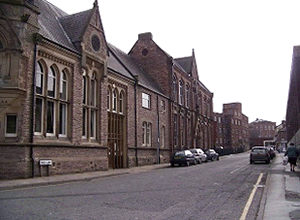
- the Silk Mill
- [click on the picture to enlarge it]
There was a silk industry in the area, at Macclesfield, a textile town to the South of Manchester. See (left) a photo of the Silk Mill (at the end of the street, to the left). Weaving took place on the top floor with large windows so that light would come in.
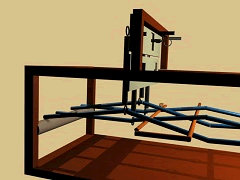
- A computer model of a Jacquard loom
- [click on the picture to enlarge it]
A computer model of a Jacquard loom; such looms were invented in Lyons to weave motifs in silk in the 18th and early 19th centuries, and used in England.
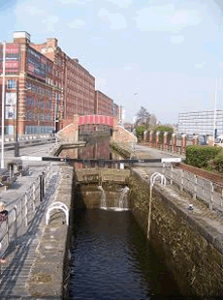
- Cotton mills at Ancoats
- Distant view
[click on the picture to enlarge it]
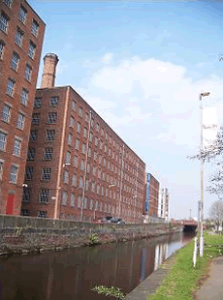
- Cotton mills at Ancoats
- Closer view
[click on the picture to enlarge it]
Cotton mills at Ancoats, in the Northern suburbs of Manchester - two views, a more distant one in context and a closer view: the characteristic industrial architecture, high buildings with tall windows (late 18th-early 19th c.).
The Ancoats mill is on the Rochdale canal (late 18th century); one of the locks can be seen on the left - canals were essential to industry.
Spinning machines, after the Arkwright model mentioned above, were later housed in long rows in large rooms in mills.
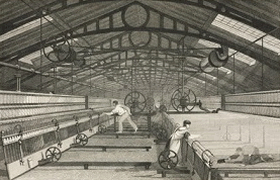
- Cotton mills
- Engraving of the 1830’s
[click on the picture to enlarge it]
You may see such machines still working at the Museum of Science and Industry in Manchester (see particularly the section « The world’s first industrial city »), where industrial history can now be studied, and at New Lanark Mills in Scotland.
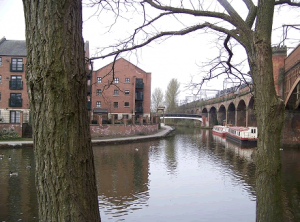
- The Bridgewater canal
- [click on the picture to enlarge it]
Canals in Manchester started with the Bridgewater canal (left), built by the Duke of Bridgewater in the 1760s to bring coal from his Worsley mines to Manchester, which contributed to the development of industry.
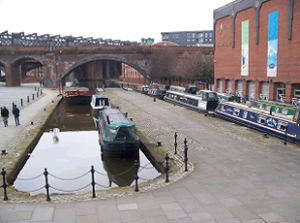
- The Bridgewater canal
- [click on the picture to enlarge it]
The unloading bay has a ’tuning fork’ design, with the canal (in the distance in the photo) separating into two basins - one basin in the left front of the photo and one to the right on the other side of the quay - so as to allow two barges to be unloaded simultaneously.
This was the beginning of ’canalmania’, the construction of a canal network.

